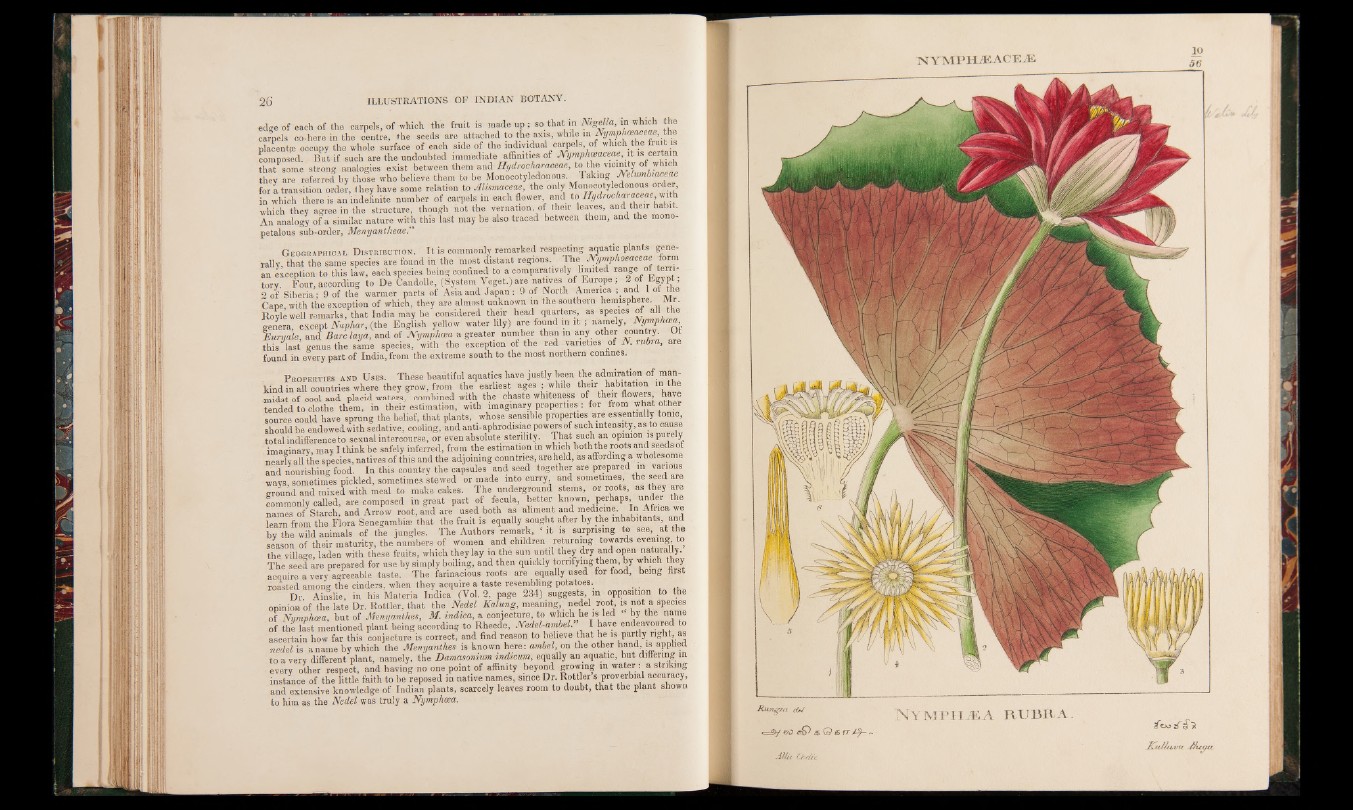
edge of each of the carpels, of which the fruit is made up; so thatm Ntgella, in which the
carpels co-here in the centre, the seeds are attached to the axis, while in Nymphoeacecw, the
placenta occupy the whole surface of each side of the individual carpels, of which the fruit is
composed. But if such are the undoubted immediate affinities of Nymphoeaceae, it is certain
that some strong analogies exist between them and Hydrocharaceae, to the vicinity oi which
thev are referred by those who believe them to be Monocotyledonous. Taking Nelumbiaceae
for‘a transition order, they have some relation to Alismaceae, the only Monocotyledonous order,
in which there is an indefinite number of carpels in each flower, and to Hydrocharaceae, with
which they agree in the structure, though not the vernation of their leaves, andAlien habit.
An analogy of a similar nature with this last may be also traced' between them, and the mono-
petalous sub-order, Menyantheae
G eographical D istr ibu t ion. I t is commonly remarked respecting aquatic plants generally,
that the same species are found in the most distant regions. The Nymphoeaceae form
an exception to this law, each species being confined to a comparatively limited range o tte in -
tory. Four, according to De Candolle, (System Veget.)are natives of Europe-; - 2 ot Egypt,
2 of Siberia; 9 of the warmer parts of Asia and Japan ; 9 of North America ; and 1 of the
Cape, with the exception of which, they are almost unknown in the southern hemisphere. M r.
Rovle well remarks, that India may be considered their head quarters, as species ot all the
genera, except Nuphar, (the English yellow water lily) are found in it ; namely, Nymphcea
Euruale, and Bare laya, and of Nymphcea a greater number than m any other country. Ot
this last genus the same species, with the exception of the red varieties of N. rubra, are
found in every part of India, from the extreme south to the most northern confines.
P roperties and Uses. These beautiful aquatics have justly been the admiration of mankind
in all countries where they grow, from the earliest ages ; while their habitation in the
midst of cool and placid waters, combined with the chaste whiteness of their flowers, have
tended to clothe them, in their estimation, with imaginary properties : for from what other
source could have sprung the belief, that plants, whose sensible properties are essentially tonic,
should be endowed with sedative, cooling, and anti-aphrodisiac powers of such intensity, as to cause
total indifference to sexual intercourse, or evenahsolute sterility. That such an opinion is purely
imaginary, may I think be safely inferred, from the estimation in which both the roots and seeds of
nearly all the species, natives of this and the adjoining countries, are held, as affording a wholesome
and nourishing food. In this country the capsules and seed together are prepared in various
ways sometimes pickled, sometimes stewed or made into curry and sometimes, the seed are
ground and mixed with meal to make cakes. The underground stems, or roots, as they are
commonly called, are composed in great part of fecula, better known perhaps, under the
names of Starch, and Arrow root, and are used both as aliment and medicine. In Africa we
learn from the Flora Senegambise that the fruit is equally sought after by the inhabitants, and
by the wild animals of the jungles. The Authors remark, ‘ it is surprising to see, at the
season of their maturity, the numbers of women and children returning towards evening, to
the village, laden with these fruits, which they lay in the sun until they dry and open naturally.
The seed are prepared for use by simply boiling, and then quickly terrifying them, by which they
acquire a very agreeable taste. The farinacious roots are equally used for foot;, being first
roasted among the cinders, when they acquire a taste resembling potatoes.
Dr Ainslie, in his Materia Indica (Vol. 2, page 234) suggests, m opposition to the
opinion of the late Dr. Rottler, that the Nedel Kalung, meaning, nedel root, is not a species
of Nymphcea, but of Menyanthes, M. indica, a conjecture to which he is led by the name
of the last mentioned plant being according to Rheede, Nedel-ambel. I have endeavoured to
ascertain how far this conjecture is correct, and find reason to believe that he is partly right, as
nedel is aname by which the Menyanthes is known here; ambel, on the other hand, is applied
to a very different plant, namely, the Damasonium indicum, equally an aquatic, but differing in
every other respect, and having no one point of affinity beyond growing in water : a striking
instance of the little faith to be reposed in native names, since Dr. Rottler s proverbial accuracy,
and extensive knowledge of Indian plants, scarcely leaves room to doubt, that the plant shown
to him as the Nedel was truly a Nymphcea.
N Y M P H Æ A C E Æ
10
5 6
M u n f f z " M N y m p h æ a r i j b r a
c=gy 6 0 Æ 0 ( 5 ITÂÿ- ~
l£ u lliv u c i .l/ie o a .
-ilia Cocùlc